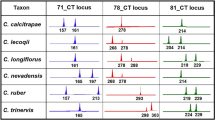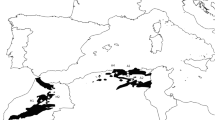Abstract
We report on the isolation and characterization of eight microsatellite markers from repetitive DNA enriched libraries for Cryptocarya chinensis from lower subtropical China. These are the first microsatellite loci reported for Cryptocarya species. The number of alleles ranged from three to nine. Observed and expected heterozygosities ranged from 0.0518 to 0.9910 and 0.5241 to 0.7935 for polymorphic loci, respectively. These markers will allow analyses of the baseline genetic variability and population structure of C. chinensis to enrich our scientific understanding of forest fragmentation on genetic health of this species and provide strategies for effective conservation and management in this area.
Similar content being viewed by others
References
Belkhir K, Borsa P, Chikhi L, Raufaste N, Bonhomme F (1996–2004) GENETIX 4.05, logiciel sous Windows TM pour la génétique des populations. Laboratoire Génome, Populations, Interactions, CNRS UMR 5000. Université de Montpellier II, Montpellier (France)
Doyle JJ (1991) DNA protocols for plants - CTAB total DNA isolation. In: Hewitt GM, Johnston A (eds) Molecular Techniques in Taxonomy. Springer-Verlag, Berlin, Germany, pp 283–293
Halkett F, Simon J-C, Balloux F (2005) Trackling the population genetics of clonal and partially clonal organisms. Tree 20: 194–201
Honnay O, Bossuyt B (2005) Prolonged clonal growth: escape route or route to extinction? Oikos 108:427–432
Lunt DH, Hutchinson WF, Carvalho GR (1999) An efficient method for PCR-based isolation of microsatellite arrays (PIMA). Mol Ecol 8:891–894
Ma K-P (1999) Ecosystem diversity in key areas of China. Zhejiang Scientific Technique Press, China
Raymond M, Rousset F (1995) GENEPOP (version 1.2): population genetics software for exact tests and ecumenicism. J Hered 86(3):248–249
Rozen S, Skaletsky HJ (2000) Primer3 on the WWW for general users and for biologist programmers. In: Krawetz S, Misener S (eds) Bioinformatics Methods and Protocols. Methods Mol Biol. Humana Press, Totowa, NJ, USA, pp 365–386
Acknowledgements
We thank San-Hong Gao, Sheng-Ni Tian, Ci-You Zhu, Tian-Min Wu and Wei-Nan Ye for helping collect sampling and/or assistance in the laboratory. Thank Dr Carolyne Bardeleben for reviewing and helping improving English writing. This work was supported by Natural Science Foundation of China (No. 30300055), Natural Science Foundation of Guangdong Province (No. 031264) and Science Utility Project of Guangdong Province (No. 2005B60301001).
Author information
Authors and Affiliations
Corresponding author
Rights and permissions
About this article
Cite this article
Wang, ZF., Li, G., Fu, SL. et al. Isolation and characterization of microsatellite loci in Cryptocarya chinensis in lower subtropical China. Conserv Genet 8, 1235–1237 (2007). https://doi.org/10.1007/s10592-006-9236-4
Received:
Accepted:
Published:
Issue Date:
DOI: https://doi.org/10.1007/s10592-006-9236-4




